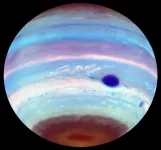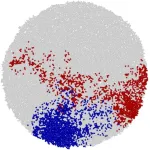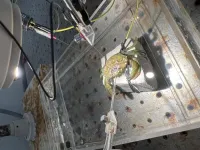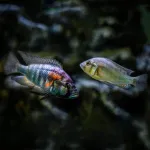(Press-News.org) While Jupiter's Great Red Spot has been a constant feature of the planet for centuries, University of California, Berkeley, astronomers have discovered equally large spots at the planet's north and south poles that appear and disappear seemingly at random.
The Earth-size ovals, which are visible only at ultraviolet wavelengths, are embedded in layers of stratospheric haze that cap the planet's poles. The dark ovals, when seen, are almost always located just below the bright auroral zones at each pole, which are akin to Earth's northern and southern lights. The spots absorb more UV than the surrounding area, making them appear dark on images from NASA's Hubble Space Telescope. In yearly images of the planet taken by Hubble between 2015 and 2022, a dark UV oval appears 75% of the time at the south pole, while dark ovals appear in only one of eight images taken of the north pole.
The dark UV ovals hint at unusual processes taking place in Jupiter's strong magnetic field that propagate down to the poles and deep into the atmosphere, far deeper than the magnetic processes that produce the auroras on Earth.
The UC Berkeley researchers and their colleagues reported the phenomena today (Nov. 26) in the journal Nature Astronomy.
Dark UV ovals were first detected by Hubble in the late 1990s at the north and south poles and subsequently at the north pole by the Cassini spacecraft that flew by Jupiter in 2000, but they drew little attention. When UC Berkeley undergraduate Troy Tsubota conducted a systematic study of recent images obtained by Hubble, however, he found they were a common feature at the south pole — he counted eight southern UV-dark ovals (SUDO) between 1994 and 2022. In all 25 of Hubble's global maps that show Jupiter's north pole, Tsubota and senior author Michael Wong, an associate research astronomer based at UC Berkeley's Space Sciences Laboratory, found only two northern UV-dark ovals (NUDO).
Most of the Hubble images had been captured as part of the Outer Planet Atmospheres Legacy (OPAL) project directed by Amy Simon, a planetary scientist at the NASA Goddard Space Flight Center and a co-author of the paper. Using Hubble, OPAL astronomers make yearly observations of Jupiter, Saturn, Uranus and Neptune to understand their atmospheric dynamics and evolution over time.
"In the first two months, we realized these OPAL images were like a gold mine, in some sense, and I very quickly was able to construct this analysis pipeline and send all the images through to see what we get," said Tsubota, who is in his senior year at UC Berkeley as a triple major in physics, mathematics and computer science. "That's when we realized we could actually do some good science and real data analysis and start talking with collaborators about why these show up."
Wong and Tsubota consulted two experts on planetary atmospheres — Tom Stallard at Northumbria University in Newcastle-upon-Tyne in the UK and Xi Zhang at UC Santa Cruz — to determine what could cause these areas of dense haze. Stallard theorized that the dark oval is likely stirred from above by a vortex created when the planet's magnetic field lines experience friction in two very distant locations: in the ionosphere, where Stallard and other astronomers previously detected spinning motion using ground-based telescopes, and in the sheet of hot, ionized plasma around the planet shed by the volcanic moon Io.
The vortex spins fastest in the ionosphere, progressively weakening as it reaches each deeper layer. Like a tornado touching down on dusty ground, the deepest extent of the vortex stirs up the hazy atmosphere to create the dense spots Wong and Tsubota observed. It's not clear if the mixing dredges up more haze from below or generates additional haze.
Based on the observations, the team suspects that the ovals form over the course of about a month and dissipate in a couple of weeks.
“The haze in the dark ovals is 50 times thicker than the typical concentration,” said Zhang, “which suggests it likely forms due to swirling vortex dynamics rather than chemical reactions triggered by high-energy particles from the upper atmosphere. Our observations showed that the timing and location of these energetic particles do not correlate with the appearance of the dark ovals.”
The findings are what the OPAL project was designed to discover: how atmospheric dynamics in the solar system's giant planets differ from what we know on Earth.
"Studying connections between different atmospheric layers is very important for all planets, whether it's an exoplanet, Jupiter or Earth," Wong said. "We see evidence for a process connecting everything in the entire Jupiter system, from the interior dynamo to the satellites and their plasma torii to the ionosphere to the stratospheric hazes. Finding these examples helps us to understand the planet as a whole."
The work was supported by the National Aeronautics and Space Administration.
END
Magnetic tornado is stirring up the haze at Jupiter's poles
Unusual magnetically driven vortices may be generating Earth-size concentrations of hydrocarbon haze
2024-11-26
ELSE PRESS RELEASES FROM THIS DATE:
Cancers grow uniformly throughout their mass
2024-11-26
Researchers at the University of Cologne and the Centre for Genomic Regulation (CRG) in Barcelona have discovered that cancer grows uniformly throughout its mass, rather than at the outer edges. The work, published today in the journal eLIFE, challenges decades-old assumptions about how the disease grows and spreads.
“We challenge the idea that a tumour is a ‘two-speed’ entity with rapidly dividing cells on the surface and slower activity in the core. Instead, we show they are uniformly growing masses, where every region is equally active and has the potential ...
Researchers show complex relationship between Arctic warming and Arctic dust
2024-11-26
The Arctic is warming two to four times faster than the global average. A recent study by researchers in Japan found that dust from snow- and ice-free areas of the Arctic may be an important contributor to climate change in the region. The findings were published in the journal npj Climate and Atmospheric Science.
According to one view, higher temperatures in the Arctic are thought to lead to the region's clouds containing more liquid droplets and fewer ice crystals. Clouds become thicker, longer lasting, ...
Brain test shows that crabs process pain
2024-11-26
Researchers from the University of Gothenburg are the first to prove that painful stimuli are sent to the brain of shore crabs providing more evidence for pain in crustaceans. EEG style measurements show clear neural reactions in the crustacean's brain during mechanical or chemical stimulation.
In the search for a better welfare of animals that we humans kill for food, researchers at the University of Gothenburg have chosen to focus on decapod crustaceans. This includes shellfish delicacies such as prawns, lobsters, crabs and crayfish that we both catch wild and farm. Currently, ...
Social fish with low status are so stressed out it impacts their brains
2024-11-26
Social stress is bad for your brain. It’s a prime suspect in the accumulation of oxidative stress in the brain, which is believed to contribute to mental health and neurodegenerative disorders — but the mechanisms that turn social stress into oxidative stress, and how social status affects this, are poorly understood. By studying a highly social, very hierarchical fish species, cichlids, scientists have now found that social stress raises oxidative stress in the brains of low-status fish.
“We found that low rank was generally linked to higher levels of oxidative stress in the brain,” said Dr Peter Dijkstra of ...
Predicting the weather: New meteorology estimation method aids building efficiency
2024-11-26
Due to the growing reality of global warming and climate change, there is increasing uncertainty around meteorological conditions used in energy assessments of buildings. Existing methods for generating meteorological data do not adequately handle the interdependence of meteorological elements, such as solar radiation, air temperature, and absolute humidity, which are important for calculating energy usage and efficiency.
To address this challenge, a research team at Osaka Metropolitan University’s Graduate School of Human Life and Ecology—comprising Associate ...
Inside the ‘swat team’ – how insects react to virtual reality gaming
2024-11-26
Humans get a real buzz from the virtual world of gaming and augmented reality but now scientists have trialled the use of these new-age technologies on small animals, to test the reactions of tiny hoverflies and even crabs.
In a bid to comprehend the aerodynamic powers of flying insects and other little-understood animal behaviours, the Flinders University-led study is gaining new perspectives on how invertebrates respond to, interact with and navigate virtual ‘worlds’ created by advanced entertainment technology.
Published in the ...
Oil spill still contaminating sensitive Mauritius mangroves three years on
2024-11-26
Three years after bulk carrier MV Wakashio ran aground on a coral reef off Mauritius, spilling 1000 tonnes of a new type of marine fuel oil, Curtin University-led research has confirmed the oil is still present in an environmentally sensitive mangrove forest close to important Ramsar conservation sites.
Lead researcher Dr Alan Scarlett, from Curtin’s WA Organic and Isotope Geochemistry Centre in the School of Earth and Planetary Sciences, said the chemical ‘fingerprint’ of the oil found ...
Unmasking the voices of experience in healthcare studies
2024-11-26
Researchers are calling for a formal process that recognises and acknowledges the invaluable contributions of those with lived experience in healthcare research.
New research by Flinders University published in the Patient Education and Counselling journal exposes underlying issues in academic engagement and calls for better processes to credit those with lived experiences.
“With the growing awareness of the importance of diversity and inclusion in research, it is time for the research community to monitor not only how often, but also how well people with lived experience are involved,” says Associate Professor Elizabeth Lynch.
Associate Professor Lynch from the College of ...
Pandemic raised food, housing insecurity in Oregon despite surge in spending
2024-11-26
Despite a heavy infusion of public and private support during the COVID-19 pandemic, Medicaid and Medicare beneficiaries in Oregon reported that housing and food insecurity shot up during the onset of the pandemic in March of 2020 — and their basic needs remained in doubt through at least the end of the following year.
The survey data were reported in a study led by Oregon Health & Science University and published today in the Annals of Family Medicine.
The Oregon study provides a state-specific dimension to a nationwide survey ...
OU College of Medicine professor earns prestigious pancreatology award
2024-11-26
Min Li, Ph.D., a George Lynn Cross Professor of Medicine, Surgery and Cell Biology at the University of Oklahoma College of Medicine and Associate Director for Global Oncology at OU Health Stephenson Cancer Center, will receive the 2024 Palade Prize from the International Association of Pancreatology.
The Palade Prize, the IAP’s most distinguished award for research excellence, recognizes Li’s contributions to the field of pancreatology, which is dedicated to discovering new methods of identifying, diagnosing and treating diseases of the pancreas such as pancreatic ...
LAST 30 PRESS RELEASES:
Deepest gas hydrate cold seep ever discovered in the arctic: International research team unveils Freya Hydrate Mounds at 3,640 m depth.
Integrating light and structure: Smarter mapping for fragile wetland ecosystems
ACA-SIM: A robust way to decode satellite signals over complex waters
Probiotics can restore gut microbiome in breastfed infants
AI could help predict nutrition risks in ICU patients, study finds
Federal EITC has unexpected result, researchers say – it decreases domestic violence
Researchers identify gene that calms the mind and improves attention in mice
Artificial metabolism turns waste CO2 into useful chemicals
Ancient sea anemone sheds light on animal cell type evolution
Begging gene leads to drone food
How climate policies that incentivize and penalize can drive the clean energy transition
Can community awareness campaigns in low-resource areas improve early diagnosis of colorectal cancer?
Stardust study resets how life’s atoms spread through space
Practical education: Clinical scenario-based program development
The impact of family dynamics on eating behaviour – how going home for Christmas can change how you eat
Tracing the quick synthesis of an industrially important catalyst
New software sheds light on cancer’s hidden genetic networks
UT Health San Antonio awarded $3 million in CPRIT grants to bolster cancer research and prevention efforts in South Texas
Third symposium spotlights global challenge of new contaminants in China’s fight against pollution
From straw to soil harmony: International team reveals how biochar supercharges carbon-smart farming
Myeloma: How AI is redrawing the map of cancer care
Manhattan E. Charurat, Ph.D., MHS invested as the Homer and Martha Gudelsky Distinguished Professor in Medicine at the University of Maryland School of Medicine
Insilico Medicine’s Pharma.AI Q4 Winter Launch Recap: Revolutionizing drug discovery with cutting-edge AI innovations, accelerating the path to pharmaceutical superintelligence
Nanoplastics have diet-dependent impacts on digestive system health
Brain neuron death occurs throughout life and increases with age, a natural human protein drug may halt neuron death in Alzheimer’s disease
SPIE and CLP announce the recipients of the 2025 Advanced Photonics Young Innovator Award
Lessons from the Caldor Fire’s Christmas Valley ‘Miracle’
Ant societies rose by trading individual protection for collective power
Research reveals how ancient viral DNA shapes early embryonic development
A molecular gatekeeper that controls protein synthesis
[Press-News.org] Magnetic tornado is stirring up the haze at Jupiter's polesUnusual magnetically driven vortices may be generating Earth-size concentrations of hydrocarbon haze







